This day last year saw a lot of nostalgia posts on the internet regarding the Sega Dreamcast, launched 10 years prior to that day (on 9/9/99). Regrettably, none of the retrospectives that I read really seemed to mention the homebrew potential, which is the aspect that interested me. On the occasion of the DC’s 11th anniversary, I wanted to remind myself how to build something for the unit and do so using modern equipment and build tools.

Background
Like many other programmers, I initially gained interest in programming because I desired to program video games. Not content to just plunk out games on a PC, I always had a deep, abiding ambition to program actual video game hardware. That is, I wanted to program a purpose-built video game console. The Sega Dreamcast might be the most ideal candidate to ever emerge for that task. All that was required to run your own software on the unit was the console, a PC, some free software tools, and a special connectivity measure.
The Equipment
Here is the hardware required (ideally) to build software for the DC:
- The console itself (I happen to have 3 of them laying around, as pictured above)
- Some peripherals: Such as the basic DC controller, the DC keyboard (flagship title: Typing of the Dead), and the visual memory unit (VMU)
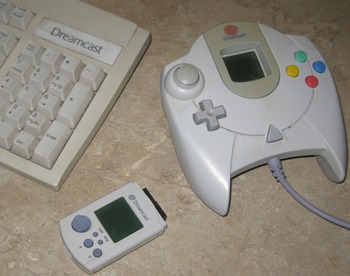
- VGA box: The DC supported 480p gaming via a device that allowed you to connect the console straight to a VGA monitor via 15-pin D-sub. Not required for development, but very useful. I happen to have 3 of them from different third parties:
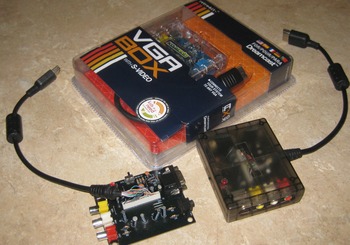
- Finally, the connectivity measure for hooking the DC to the PC.
There are 2 options here. The first is rare, expensive and relatively fast: A DC broadband adapter. The second is slower but much less expensive and relatively easy to come by– the DC coder’s cable. This was a DB-9 adapter on one end and a DC serial adapter on the other, and a circuit in the middle to monkey with voltage levels or some such; I’m no electrical engineer. I procured this model from the notorious Lik Sang, well before that outfit was sued out of business.
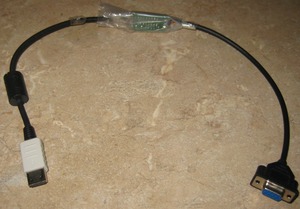
Dealing With Legacy
Take a look at that coder’s cable again. DB-9? When was the last time you owned a computer with one of those? And then think farther back to the last time to had occasion to plug something into one of those ports (likely a serial mouse).
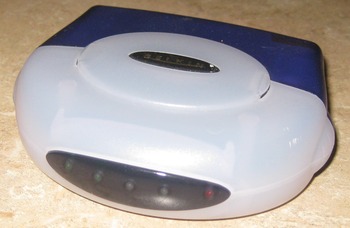
A few years ago, someone was about to toss out this Belkin USB to DB-9 serial converter when I intervened. I foresaw the day when I would dust off the coder’s cable. So now I can connect a USB serial cable to my Eee PC, which then connects via converter to a different serial cable, one which has its own conversion circuit that alters the connection to yet another type of serial cable.
Bits is bits is bits as far as I’m concerned.
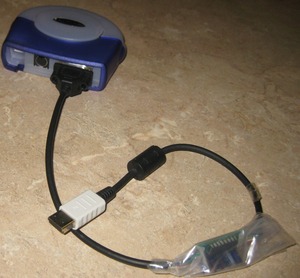
Putting It All Together
Now to assemble all the pieces (plus a monitor) into one development desktop:
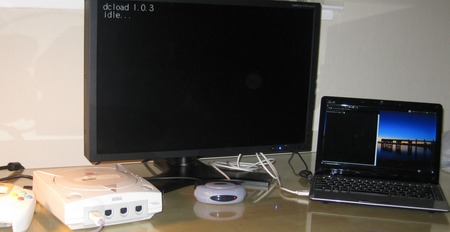
The monitor says “dcload 1.0.3, idle…”. That’s a custom boot CD-ROM that is patiently waiting to receive commands, code and data via the serial port.
Getting The Software
Back in the day, homebrew software development on the DC revolved around these components:
- GNU binutils: for building base toolchains for the Hitachi SH-4 main CPU as well as the ARM7-based audio coprocessor
- GNU gcc/g++: for building compilers on top of binutils for the 2 CPUs
- Newlib: a C library intended for embedded systems
- KallistiOS: an open source, real-time OS developed for the DC
The DC was my first exposure to building cross compilers. I developed some software for the DC in the earlier part of the decade. Now, I am trying to figure out how I did it, especially since I think I came up with a few interesting ideas at the time.
Struggling With the Software Legacy
The source for KallistiOS has gone untouched since about 2004 but is still around thanks to Sourceforge. The instructions for properly building the toolchain have been lost to time, or would be were it not for the Internet Archive’s copy of a site called Hangar Eleven. Also, KallistiOS makes reference to a program called ‘dc-tool’ which is needed on the client side for communicating with dcload. I was able to find this binary at the Boob! site (well-known in DC circles).
I was able to build the toolchain using binutils 2.20.1, gcc 4.5.1 and newlib 1.18.0. Building the toolchain is an odd process as it requires building the binutils, then building the C compiler, then newlib, and then building the C compiler again along with the C++ compiler because the C++ compiler depends on newlib.
With some effort, I got the toolchain to build KallistiOS and most of its example programs. I documented most of the tweaks I had to make, several of them exactly the same as this one that I recently discovered while resurrecting a 10-year-old C program (common construct in C programming of old?).
Moment of Truth
So I had some example programs built as ELF files. I told dc-tool to upload and run them on the waiting console. Unfortunately, the tool would just sort of stall, though some communication had evidently taken place. It has been many years since I have seen this in action but I recall that something more ought to be happening.
Plan B (Hardware)
This is the point that I remember that I have been holding onto one rather old little machine that still has a DB-9 serial port. It’s not especially ergonomic to set up. I have to run it on my floor because, to connect it to my network, I need to run a 25′ ethernet cable that just barely reaches from the other room. The machine doesn’t seem to like USB keyboards, which is a shame since I have long since ditched any PS/2 keyboards. Fortunately, the box still has an old Gentoo distro and is running sshd, a holdover from its former life as a headless box.

Now when I run dc-tool, both the PC and DC report the upload progress while pretty overscan bars oscillate on the DC’s monitor. Now I’m back in business, until…
Plan C (Software)
None of these KallistiOS example programs are working. Some are even reporting catastrophic failures (register dumps) via the serial console. That’s when I remember that gcc can be a bit fickle on CPU architectures that are not, shall we say, first-class citizens. Back in the day, gcc 2.95 was a certified no-go for SH-4 development. 3.0.3 or 3.0.4 was called upon at the time. As I’m hosting this toolchain on x86_64 right now, gcc 3.0.4 can’t even be built (predates the architecture).
One last option: As I searched through my old DC project directories, I found that I still have a lot of the resulting binaries, the ones I built 7-8 years ago. I upload a few of those and I finally see homebrew programming at work again, including this old program (described in detail here).
Next Steps
If I ever feel like revisiting this again, I suppose I can try some of the older 4.x series to see if they build valid programs. Alternatively, try building an x86_32-hosted 3.0.4 toolchain which ought to be a known good. And if that fails, search a little bit more to find that there are still active Dreamcast communities out there on the internet which probably have development toolchain binaries ready for download.
GCC 4.3 and 4.4 build just fine as cross-compiler for SH-4 running on x86_64, but not gcc 4.5.
@Mans: Is it a known issue that gcc 4.5.x outputs bad code for SH-4?
GCC 4.5 fails to be built for SH-4 and thus outputs no code at all.
I am always amazed at someone having 3 game consoles… Considering I never had even a single one :-).
@Reimar: 3 _different_ consoles I could understand, but 3 of the same… oh well, this is Mike after all.
BTW, that anon comment was from me. This browser didn’t have the fields pre-filled.
@Mans what’s strange in having three different consoles? ^^;;
By the way, check the chip on the USB converter and the cable used; I have had a couple of bad experiences with a customer of mine when they provided me the converter and cable… Nowadays I stick to my three PL2303 converters (ordered from HK) and sane cabling.
About having 3 of these units: I only had 1 for the past 9 years. However, a little while ago, when I got the idea of revisiting these programming ideas, I tried to make it work but had some problems. That’s when I found someone on Craigslist selling 2 bare consoles for very cheap. The fact that he had 2 bare consoles was another strange tale in itself.
When I got them home, neither worked. Then I figured out what I was doing wrong and all 3 of them work now.
@Mans: I was able to successfully build SH-4 gcc with both gcc 4.5.0 and 4.5.1. When I compile the programs with gcc 4.5.1, the resulting binaries are very much non-NULL. That said, I’ll still be trying the older compilers.
@Flameeyes: As far as the USB-serial solution, I use that USB cable all the time to hook to a scanner and an external HD. The DC coder’s cable worked fine as well when it was the only cable in play. That means it’s possible that the Belkin converter might be problematic (possibly why someone was discarding it? I thought it was because they had no use for it in this day and age). I might spring for a new converter since they don’t cost much.
Maybe you used a different configuration. The build process failed quite miserably for me. Not that I really care, not having any working sh-4 hardware anyway. I do have a weird dev board that I’d need a JTAG debugger to do anything with…